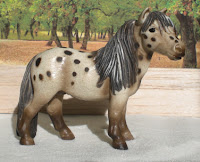The Georgian Grande – A Saddlebred with a Twist
by Samantha Kroese
Hartland's Large Saddlebred Stallion
(possibly too heavy but definitely closer to Grande than purebred ASB!)
I’ve seen quite an explosion in the hobby of this new
exciting breed. Although most people seem to be quite confused about it. First
of all the name of the breed is The Georgian Grande. I’ve seen it spelled
Georgia Grand and various other spellings but Georgian Grande is the correct
spelling (meaning Grand Horse of Georgia).
Their registry website for real horses is here: http://www.georgiangrande.com/
According to their website (which the registry is usually
considered ‘the’ authority of the breed of course) the breed was developed with
the intent to created a Saddlebred horse that had heavier bone/heavier look to
it.
It was created in 1970 by a breeder by the name of George Wagner Jr. who
had seen pictures of ‘old’ Saddlebreds and thought the breed was more sensible
in the past for work so he started crossing Saddlebreds with Percherons (and
other draft breeds). With the intent to get foals that look like a Saddlebred
only had more substance to them instead of the lean long look they’d gotten for
halter showing. Another apparent attempt was to cool the hyper attitude of the breed
with the less excitable personalities of draft horses. The original breeders
wanted to recreate horses like General Lee’s Traveller.
A Georgian Grande today can be anywhere between 25% and 75%
American Saddlebred Blood. The only other blood that is allowed to be crossed
with it is the draft breeds that follow: Percheron, Clydesdale, Shire, Irish
Draught, Belgian Draft and Friesian. Gypsy Vanner and Drum Horses are only
accepted if they are registered with their breed registries and have a proven
pedigree.
They are commonly used for Dressage and similar events.
American Saddlebreds have a distinct look and the Georgian Grande seeks to preserve that while adding substance.
Their breed standard states that the goal of this breed is
to create a perfect blend of both worlds, resulting in a heavier boned
“Baroque” style Saddlebred.
This does not mean the horse looks exactly like a purebred
Friesian would! The horse should look like a Saddlebred with more weight and
bone to it. Purebred Draft type, Warmblood type, or Friesian/Carriage type do
not fit in with the breed’s mission or breed standard. More often than not the
breed does not have (or isn’t shown with) feathering. Feathering is allowed or
it is allowed to be shaved off.
You can see their entire breed standard here and it is quite
detailed: http://www.georgiangrande.com/Fun_Photos/Breed%20Standard.html
I’ve had people argue that they’ve found real Georgians that
look like a purebred Friesian, or a warmblood, or any other type under the sun.
One should always, always, visit the breed’s website and read their breed
standard and mission and look at champions or approved stallions. Google or
other ‘image’ searches can show images that are incorrect or mislabeled or
maybe the horse just isn’t the best example of the breed.
While Georgian Grande may seem like an answer to all those
odd colored drafts or Friesians one should always keep in mind that the
standard calls for a type that is very different than purebreds of any of those
breeds look. The breed even penalizes a short thick neck (which is what most
purebred draft and Friesians have).
Models that could possibly be similar to the standard of the Georgian Grande:
Peter Stone’s “Chip” Standing Draft Horse
Hartland’s Large ASB
Five Gaiter
Other horses of similar look/type
Your goal is to have a Saddlebred 'type' horse that has a heavier frame/more meat on them. Normally a purebred Saddlebred is very long and lean with fine delicate bone structure.
Things to avoid:
Models with a Warmblood look (think Hanoverian and similar molds)
Models that have draft or Friesian type (remember you want a
long thin neck, longer back, long legs and high action these are not things
that drafts/Friesians are known for)
Purebred ASB - Notice the long neck, long body/spine, long legs and the head that has a long almost stretched look to it.
Purebred Friesian - Notice the heavy thick legs, the thick short body, and the thick short neck. Their heads are also thicker and have a less stretched appearance.
Purebred Percheron - Notice again the short thick legs/body/neck and the heavier head.
The Five Gaiter is much thicker and heavier than most purebred ASBs are today. He is closer to the old style ASBs the Georgian Grande breeders hope to imitate. But the Georgian Grande should ideally have the long look of the Saddlebred still that the breed is known for.
This is a lovely newer breed and I hope this clears up some
confusion you might have had about it.



























